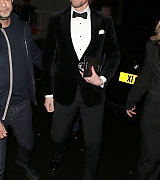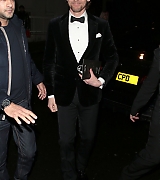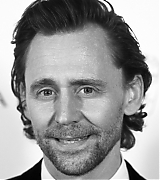Quint, from the website Ain’t It Cool, has posted a Q&A with Tom on the set of “Crimson Peak” a while ago. Read it below.
So, I was pulled away from the set visit and led to Hiddleston’s trailer to do this chat. He opened the door half in his costume, his lacy shirt billowing in the breeze and the whole nine yards. No shit, it was like a Harlequin romance cover come to life and I realized there were about 2 million girls in this world that would have slit my throat to have been in this position.
His trailer smelled strongly of incense (the good shit, not the headshop skunk crap) and he had photos and art taped up on the cabinets, all relating to his character in some way. Lots of Victorian era men and women, mostly high society types and there were some creepy dead bride stuff, too. I bring that part up because I touch on it in the below interview.
After some small chit chat we sat down and began the below interview. It’s a good one. This guy is a great talker and wickedly intelligent to boot.
Quint: Let’s start by talking a little about Guillermo.
Tom Hiddleston: I love him. He’s right at the top of the leader board of all the directors I’ve worked with. He went straight in to number one.
Quint: What’s great about Guillermo is he’s a visionary, but doesn’t have the up-his-own-ass baggage a lot of visionary directors have.
Tom Hiddleston: Yeah, he’s chill, passionate, warm, inspiring and deeply knowledgeable. I mean, he knows when to be irreverent and mess around and have a good time, but he also knows when to be focused and serious and delicate. It’s amazing working with him. I think I’ve said this before, but he’s like a great Mexican bear of warmth and passion. He’s like a Mexican Baloo.
Quint: Perfect description. I’ve known Guillermo since the late ’90s. He used to live in Austin and only about a mile from my house, so we’d do movie nights every once in a while. But I’ve only actually seen him work a couple of times.
Tom Hiddleston: Right.Quint: So, it’s funny visiting this morning and we’re just old friends catching up, bullshitting about geek stuff like how awesome The Haunted Mansion is, and then he’ll glance at the monitor and immediately go “I need this, this, this and use the 50mm on the next set up,” and then turn around pick right up where he left off.
Tom Hiddleston: Yeah, he’s an expert. He lives and breathes it. It’s his world. He’s said this to me. He said, “This is what I do. I’m terrible at being regular. I’m not a good regular guy, it just doesn’t make me tick.” It’s like this feeds him, like oxygen.Quint: Have you been to his house yet?
Tom Hiddleston: Not yet.Quint: He surrounds himself with storytelling. It’s funny, he almost lives like a painter or an animator. If you’ve ever seen a desk of an animator it’s all reference and stuff that inspires them. That’s his house. That’s kind of my house, too, but I’m nowhere near the artist he is.
Tom Hiddleston: I completely get it. I have a different way. At my house when I’m working on something specific the walls of my office are plastered in stuff…Quint: Like dead brides.
Tom Hiddleston: (laughs) Dead brides, yes. But then I need to have a space that is neutral, do you know what I mean? Because I feel like you can get lost in the woods. As an actor if you immerse yourself totally you have to have somewhere you can pull yourself out of the rabbit hole at some point because I really take it on. I take on every character so seriously. You just get excited and curious and you’re turning over every stone, looking in every nook and cranny, so I have a place in my house that is just white light. There are windows and you can see the world.Quint: There’s so much pressure on an actor. Every take the work of hundreds of crew is focused directly on you. You have to be prepared for that, so it must be crucial for you to not only have done the homework, but also not be too much inside your own head.
Tom Hiddleston: Yeah, it has to be automatic by then. Once you’re on set all the work has been done in a way and then it’s time to play. The best work comes from playfulness, I think. When you’ve done all the excavating and research and thinking ahead, planning, preparing, turning over different iterations of how a scene can go, how a character can play, and then get your mask on, get your disguise… your costume, hair and make-up… and then literally forget about the entire thing and be there, be present in the room. Just play with your scene partner. In this case play with Mia (Wasikowska), play with Jessica (Chastain).Quint: You can say you play with Guillermo, too. I don’t mind.
Tom Hiddleston: (laughs) And play with Guillermo. I don’t know if he’d appreciate that! But yeah, that’s what it is for me. I get ready and prepare, prepare, prepare and on the day just be there.Quint: I have to imagine it’s deadly to lock your performance in stone before you feel the chemistry of the set. I’ve been to a lot of sets and have seen a lot of actors, really good actors, that stumble with certain scenes and it was pretty clear that it took them a bit to let go of what they brought onto the set that day. They were good actors, so they made the switch, it just took them some time. Watching Mia work earlier today… I saw her play a scene one way and Guillermo gave her two words of direction and the very next take she gave it to him and it was exactly what he was going for.
Tom Hiddleston: Yeah, she’s really loose. She’s really fluid. A good analogy I always think of is you have to build the scaffolding. You have to build something. You can’t just turn up and be “Ah, bluh-bluh-bluh.” (laughs) Once you’ve got the scaffolding, at least the internal structure of a scene, then you can at least tie a rope on it and you’re safe to swing, do you know what I mean? If you build the entire building with the facade and front door then you’re locked into something. You’re rigid. You can’t move. “Well, this was where the door was going to be…” It’s much better to have a loose scaffolding and swing freely.Quint: Guillermo is not a director who is indecisive.
Tom Hiddleston: No.Quint: So, I’m sure in the very early stages of your collaboration you guys agreed on a certain groundwork for your character… the foundation, if we’re going to keep the building analogy going.
Tom Hiddleston: That’s the thing, there’s always room to maneuver. In playing a scene in character, certainly when playing Thomas Sharpe, you can play certain things straight down the middle or play things slightly oblique or left of the middle… something surprising or unexpected. Especially when you’re playing a character who is ambiguously placed in the audience’s sympathies. In this story Thomas Sharpe is the tall, dark stranger, a figure of mystery and magnetism who Edith is drawn to and you hope the audience is as well. You want him to be captivating and charming and also full of secrets. You want to basically encourage that you want to know what those secrets are.I quite like wrong footing. You don’t want the audience to be ahead of you, so there are ways of playing things where you go, “I can subvert the audience’s expectations if I play it like this,” or you can play into them if you play it (another way), then later on I can come back around. It’s all about mapping out the journey. What’s on the nose, what’s not on the nose, what’s the interesting choice. There’s a palette of choices you can make. Some are obvious, some are less obvious, and with Guillermo that’s the fun.
We had our basic template. We knew who Thomas Sharpe was, we knew he was an aristocrat, an engineer, a dreamer. He was energetic, charming and engaged. He was intellectually gifted and a big thinker, but also full of so much mystery and so much hidden darkness. It was all about how you choose to reveal what he’s hiding. That’s the fun part.
Quint: Ambiguity is always interesting. I love gray area in films and characters. You kind of are making a habit out of playing those kinds of characters because Loki is very much ambiguous, especially as he’s been developed in the last couple of Marvel films. With Loki you can never really tell when he’s sincere and when he’s playing an angle and from what I’ve heard about the character of Thomas it seems like it’s a similar gray area for you to play in.
Tom Hiddleston: Yeah, but I don’t want to draw too many parallels because in my head the only thing the characters share is they have dark hair. (laughs) But I am fascinated by people who are good at improvising in the moment. As in characters who are talented at being spontaneous, so that things aren’t pre-planned. Certain characters, in order to ensure their success and survival within a given situation, can instinctively and spontaneously make decisions which allow them to keep going.In a way, Thomas is governed by forces beyond his control. Overtly and, I think, subconsciously he’s being manipulated by other people. Guillermo and I have talked about this… over the course of the story Sharpe is beginning to understand the force of his own strength, his own indepence and his his own will as well as the obstacles in front of it.
So then you have a conversation about sincerity and insincerity, truth-telling and deception and to what extent does he know he’s lying or to what extent is he aware that he is complicit in deception. Many, many, many people on the face of this Earth tell lies convinced they are telling the truth, so they don’t even know they’re lying. Someone once said that language was invented in order to lie. It was invented in order to put a spin on a situation. “No, no… that’s not what’s happening. THIS is what’s happening.”
I’m talking in abstract terms. I’m trying not to spoil the plot, but the fascination for me in Sharpe is that he starts the film in one place and he closes the film in another and it’s as much a journey of his kind of awakening as it is anything else. Edith shines a light on the dark spots and the gray spots of his life and his soul that he hasn’t had the courage to look at. Does that make sense? But also, Thomas is complicit in something which he’s only partially aware of and through the course of the film he becomes kind of… awake. (laughs) It’s so hard to describe it! Have you read it? Do you know what it’s about?
Quint: No. It’s funny, when I saw Guillermo this morning I told him the only thing I knew about the movie was the title and the cast list. The only things we really got to talk about before he got distracted by actually, you know, making the movie, was he mentioned that the movie was as much of a fetish film for him as Pacific Rim was. That movie played directly into his love of Manga and all that stuff, but he said he was just as passionate about Victorian-era stories… Like Dickens. He mentioned the Gothic Romance feel and that Edith saw her mother as a ghost… So, the only thing I know about your character is what you’ve told me so far.
Tom Hiddleston: Loosely, to sort of inform what we’re talking about, it is a Gothic Romance in its template. Around sort of the middle of the 18th century and into the 19th Gothic Romance became an immensely popular form of literature. In fact, you can trace what we’ve come to accept as a standard trope in the mythology of ghosts to Gothic Romance. It was the first genre to invent the idea that the supernatural could be explained in emotion terms. The phenomena of the supernatural somehow arose from some unprocessed, unresolved pain or tragedy. They were spirits who needed closure.That started with Gothic Romance. Before that the supernatural was something that was thought of as something that was religious. It wasn’t something that was actually localized as an explanation of some previous damage, some past tragedy. That’s where Gothic Romance started. We’re talking about Ann Radcliffe, Horace Walpole, Edgar Allen Poe, Mary Shelley. They explained ghosts in terms of unprocessed trauma.
But also there were classic tropes in the genre as well. There was often a young, pure-hearted innocent heroine. There was often a tall, dark stranger who magnetic. There was often a decent pure-hearted hero who was present at the beginning of the story and came back at the end of the story. There was often a big castle; the Castle of Otranto or the Castle of Udolpho in The Mysteries of Udolpho. A scary, foreboding building filled with dark secrets that people didn’t want to approach. This was the beginning of the haunted house genre.
There are many, many of those elements in this film. Mia plays Edith Cushing, whose mother died when she was very young. She is independent and spirited and curious and self-willed and precocious and honest and open. Into her world comes the tall, dark stranger and they fall in love. There’s a deep, deep romance there. They get married and go back to England, where he’s from, to Allerdale Hall which is on a plot of land called Crimson Peak. Allerdale Hall is a big gothic monstrosity that is, of course, very, very old and possesses many dark secrets.
[Knock on the trailer door, the publicist saying it’s time to wrap things up]Tom Hiddleston: Five more minutes, Joe?
[Publicist says that’s good and leaves us once more.]Quint: He was trying to rescue you! That was your shot to get out of the interview!
Tom Hiddleston: (laughs) That’s alright. So, the audience follows Edith on that journey of discovery. She is the heroine and she begins to experience the house and its secrets so the audiences do, too. But what’s all so fascinating is that Guillermo is playing with the tropes. He’s going, “Here’s what you know about Gothic Romance. I’m going to give it to you and I’m also going to give you this (smacks hands together) and this (smacks hands together again) and you’ve never seen that before.”What’s really nice is the film… we’re 51 days out of 70 now, in the shoot, and the film is very gothic and very romantic in equal measures, so you get a sense of that dark foreboding that you come to expect. When you say “gothic” it conjures an idea in your mind, but it’s also so deeply romantic. It’s about ghosts, but it’s also about matters of the heart. It’s about people falling in love and following their heart.
Quint: At the end of the day you need to care about the people experiencing any kind of supernatural threat to invest you in their journey. That’s true with most films, but especially genre. Even if it’s your basic slasher… if you don’t care about Laurie Strode as a person then Halloween isn’t scary. Guillermo’s great about that. Hell, even the villains in his Spanish movies are people you can relate to.
Tom Hiddleston: Yes! Those guys are amazing, those two actors… The one in Devil’s Backbone and the one in Pan’s Labyrinth. Very memorable figures. The interesting thing about this is I think the film really keeps you guess as to who the villain really is, or even if there is one. The only spoiler I will release is that Mia Wasikowska is not playing the villain! (laughs)
 Welcome to Tom Hiddleston Online a fansite for the actor mostly know for his role in Marvel's Cinematic Universe Loki. You might also know him for his role in theater plays such as Coriolanus and Betrayal, and other films and series such as The Night Manager, War Horse, Kong: Skull Island, Crimson Peak, Only Lovers Left Alive and many more. Tom Hiddleston will be seen next on Disney's series Loki and Apple TV The Essex Serpent.
I hope you enjoy you stay and have fun!
Annie
Welcome to Tom Hiddleston Online a fansite for the actor mostly know for his role in Marvel's Cinematic Universe Loki. You might also know him for his role in theater plays such as Coriolanus and Betrayal, and other films and series such as The Night Manager, War Horse, Kong: Skull Island, Crimson Peak, Only Lovers Left Alive and many more. Tom Hiddleston will be seen next on Disney's series Loki and Apple TV The Essex Serpent.
I hope you enjoy you stay and have fun!
Annie 



































